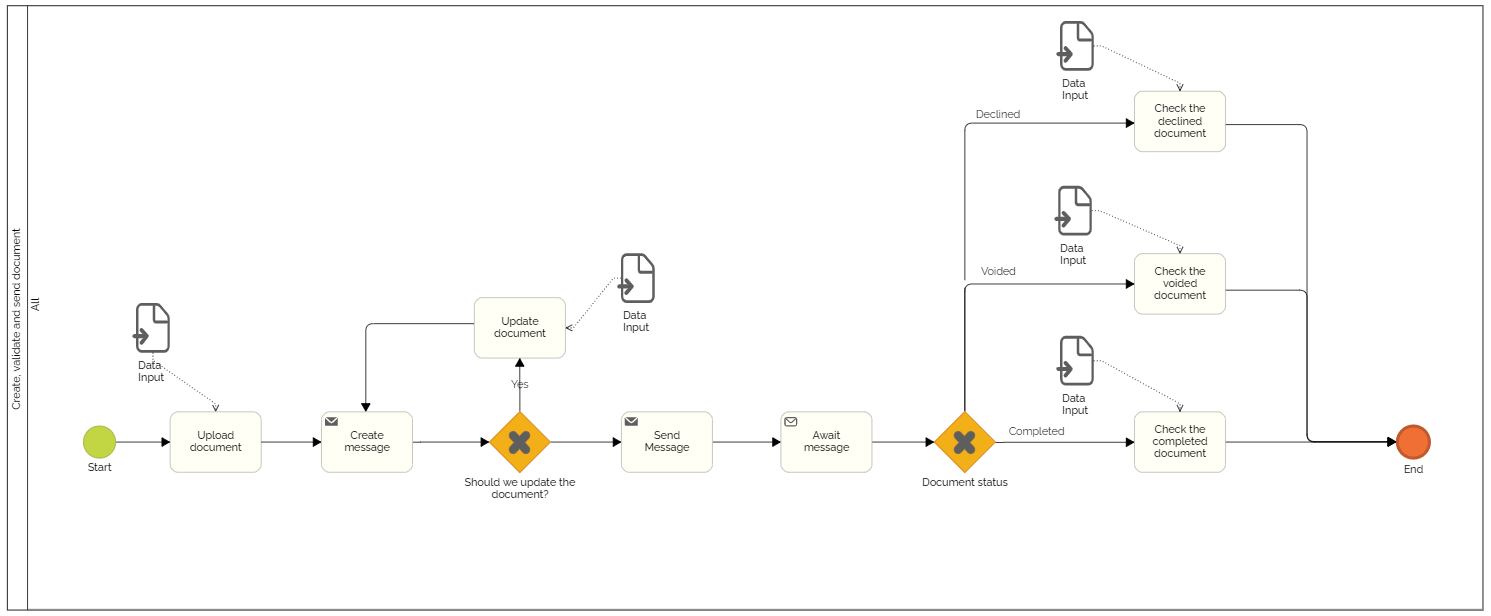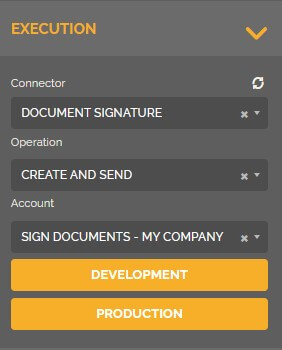In this article we will see how to configure a process to create an envelope containing a document to sign with a verification step before sending it to DocuSign.
We use this example process to demonstrate this configuration:

When the user creates a work item for this process, he must first insert the desired document(s) into a “Files Upload” field in the first task. When moving on to the next task, the system then creates an “envelope” containing the document to be signed. Then, the user has the option to review the document before sending it to DocuSign. The objective of this step is to allow the user to update the document to be signed. Once the document is validated, the system sends the envelope to DocuSign. The work item then waits to receive information from DocuSign. Depending on the status of the relevant document, the work item will follow one of 3 different exclusive gateway output flows. Each of the three tasks following the gateway aims to display the document and its associated status in DocuSign.
Configure an envelope creation task.
The first step is to configure the task that will create the envelope. The objective is to configure the document that will be sent, the list of recipient(s) and personalize the message that will be sent by DocuSign.
- Select the relevant task.
- Make sure this is a message type task with throw behavior. For information: the envelope creation configuration is only possible for message type tasks, it is not possible to use a message sending event.
- Go to the properties and choose the connector: “Document signature”.
- Choose the “Create” operation.
- In the account section, choose the DocuSign account associated with your HEFLO environment. To learn more about how to associate a DocuSign account with your HEFLO environment: Configure DocuSign integration.
From this moment, two new buttons appear:
- The “Development” button allows you to configure the creation of the envelope for test work items. The “Development” button is linked to the DocuSign developer account associated with this environment.
- The “Production” button allows you to configure the creation of the envelope for production work items once the process automation is published. The “Production” button is linked to the DocuSign account associated with this environment.
To learn more about the difference between a DocuSign account and a DocuSign developer account: Configure DocuSign integration.

We will now configure the creation of the envelope.
- Click the “Development” button.
- In the “Envelope” tab you must:
- Give the envelope a name.
- In the “Documents” section, select the field that will contain the document that will be sent by DocuSign. You must select the field used in the first task to upload the document(s). You can also choose to select a document template contained in the DocuSign account associated with your HEFLO account. To find out more: LINK.
- In the “Store Folder” section you can choose in which folder of your DocuSign account the document will be sent. If you do not select any folder, your envelope will automatically be stored in the drafts folder.
- In the “Recipients” tab you must add one or more recipients by clicking on the “+” button. You must then choose a role from those available in DocuSign, a name and an email address. You can also choose a routing order, this is useful if, for example, you want this recipient to receive the document to be signed before or after other recipients. You can also set up a code to access the document and send a private message.
- In the “Message” tab you must configure the name and body of the message that will be sent to all recipients.
Then click on confirm to validate this configuration.
Configure an envelope sending task.
The exclusive gateway after the envelope creation task allows the user to validate or update the document. To update it, you must then add the field used in the first task in the one following the output flow which precedes the return to the envelope creation task.
This configuration then allows you to update the document which will be sent to DocuSign
If the document is validated by the user, you must then configure the envelope sending task.
- Select the relevant task.
- Make sure this is a message type task with throw behavior. For information: the envelope sending configuration is only possible for message type tasks, it is not possible to use a message sending event.
- Go to the properties and choose the connector: “Document signature”.
- Choose the “Send” operation.
- Then click on the chain icon and select the envelope creation task, so that the system knows which envelope this task is associated with. After selecting the creation task, you can then find this information under the chain icon. We advise you to name these tasks well so that you can differentiate them in case you have several envelope creation tasks.
Configure an envelope receiving task.
We will now configure the envelope reception task.
- Select the relevant task.
- Make sure this is a message type task with catch behavior. For information: the envelope reception configuration is feasible for message type tasks and for message reception events.
- Go to the properties and choose the connector: “Document signature”.
- Choose the “Await envelope” operation.
- In the “Envelope Status Field” section, choose the HEFLO field that will retrieve information regarding the status of the envelope in DocuSign. This field must be of “Text” type. When the envelope sent has received action from all the recipients (in the case where the document(s) contained in the envelope have been signed), or one of the recipients (in the case where they have been declined), then this selected field will receive the final status of the envelope. There are three statuses: completed, voided and declined.
- In the “Final Combined File” section, choose the HEFLO field that will retrieve the final document contained in DocuSign. This field must be of “Files Upload” type.
- Then click on the chain icon and select the envelope sending task, so that the system knows which envelope this task is associated with. After selecting the sending task, you can then find this information under the chain icon. We advise you to name these tasks well so that you can differentiate them in case you have several envelope sending tasks.
In our example, we want the work item to follow an output flow based on the status of the document in DocuSign.
- Select the exclusive gateway, go to the properties and activate the “Is Automatic” option in the execution part.
- Create a business rule for each output flow using the field chosen in the “Envelope Status Field” section when configuring the task or message reception event. For information: whatever language you use in HEFLO, the DocuSign statuses are in English: “completed”, “voided” and “declined”.
- In each of the tasks following the gateway, add the two associated fields when configuring the task or message reception event for the “Envelope Status Field” and “Final Combined File” parts. The goal is to display the status and final document contained in DocuSign.
Create a test work item.
The setup is now complete, we will create a test work item.
Add the desired file to the first task field.
The task of creating the envelope is transparent to the user. In our configuration, the work item then goes directly to a gateway to choose whether the document needs to be updated.
For information: Once the envelope has been created, you can see the information concerning it.
- Click on the button with the three dots.
- Click on “Document Signature”.
- You then have information concerning the status of the envelope and the actions pending or taken by the recipient(s).
Choose the output flow that returns to the envelope creation task if you want to edit the document.
Then add a document in the field that corresponds to that of the first task to add it up to the existing document. If you want to replace the existing document, you must then delete the previously added one and upload the new one in the field.
For information: Once the envelope creation task is done for the second time, you then have the possibility to see the history of the envelopes that have been created.
- Click on the button with the three dots.
- Click on “Document Signature”.
- You then have the possibility to see the information concerning the different versions of the envelope.
The task sending the envelope is transparent to the user. In our configuration, the work item then goes directly to the DocuSign message waiting task. This is then blocked for the message reception type task. Once the envelope is sent, the recipient(s) receive an email. The recipient concerned must then follow the instructions explained by DocuSign to sign or decline the document concerned. The action that will be carried out by them will allow the instance to advance automatically and choose the output flow according to the status of the envelope.
You can also access this information if you are on task waiting for information from DocuSign. You can then click on “View details”.
We will sign the document.
Both recipients in our example signed the document. The work item then follows the “completed” output flow and we can find the document status and signed document in the task following the gateway.
Configure the “Production” part and publish the process automation.
Once the test has been validated, you must then make this same configuration in the “Production” part of the envelope creation task. We advise you to create the same template on your two accounts, the DocuSign developer account and the DocuSign production account, to facilitate the configuration of the “Production” part on HEFLO.
Once configured, you can then verify your process using the validation function in the “Actions” tab and publish the process automation.
